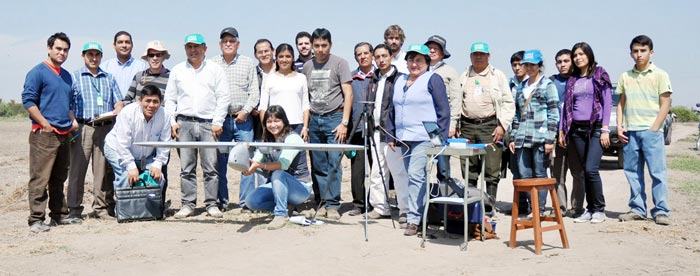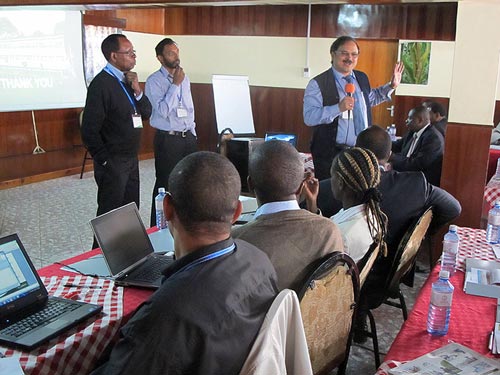 “I can now identify with accuracy plants affected with maize lethal necrotic disease,” stated Regina Tende, PhD student attached to CIMMYT, after attending the CIMMYT-Kenya Agricultural Research Institute (KARI) “Identification and Management of Maize Lethal Necrosis” workshop in Narok, Kenya, during 30 June-3 July 2013. This was not the case a few weeks ago when Tende, who is also a senior research officer at KARI-Katumani, received leaf samples from a farmer for maize lethal necrosis (MLN) verification.
“I can now identify with accuracy plants affected with maize lethal necrotic disease,” stated Regina Tende, PhD student attached to CIMMYT, after attending the CIMMYT-Kenya Agricultural Research Institute (KARI) “Identification and Management of Maize Lethal Necrosis” workshop in Narok, Kenya, during 30 June-3 July 2013. This was not the case a few weeks ago when Tende, who is also a senior research officer at KARI-Katumani, received leaf samples from a farmer for maize lethal necrosis (MLN) verification.
Tende is one of many scientists and technicians who experienced difficulty in differentiating MLN from other diseases or abiotic stresses with similar symptoms. According to Stephen Mugo, CIMMYT Global Maize Program (GMP) principal scientist and organizer of the workshop, this difficulty encouraged CIMMYT and KARI to organize this event to raise awareness about MLN among scientists, technicians, and skilled field staff; provide training on MLN diagnosis especially at field nurseries, trials, and seed production fields; train on MLN severity scoring to improve the quality of data generation in screening trials; and introduce MLN management in field screening sites to scientists, technicians, and skilled staff. The workshop brought together over 80 scientists and technicians from CIMMYT, KARI, and other national agricultural research systems (NARS) partners from Tanzania, Uganda, Rwanda, and Zimbabwe.
“It is important that all the people on the ground, particularly the technicians who interact daily with the plants and supervise research activities at the stations, understand the disease, are able to systematically scout for it, and have the ability to spot it out from similar symptomatic diseases and conditions like nutrient deficiency,” stated GMP director B.M. Prasanna.
Proper and timely identification of the MLN disease, which is a pre-requisite for effective control, is not easy. CIMMYT maize breeder Biswanath Das explains: “First of all, the disease is caused by a combination of two viruses, Maize chlorotic mottle virus (MCMV) and Sugarcane mosaic virus (SCMV). Secondly, its symptoms –severe mottling of leaves, dead heart, stunted growth (shortened internode distance), leaf necrosis, sterility, poor seed set, shriveled seeds– are not always unique to MLN but could be due to other fungal diseases and abiotic conditions.” The training workshop was one of CIMMYT/KARI initiatives to combat the disease threatening all the gains made so far in maize breeding. “With nearly 99% of the commercial maize varieties so far released in Kenya being susceptible to MLN, it is important that institutions like CIMMYT and KARI, in strong collaboration with the seed sector, develop and deploy MLN disease resistant varieties in an accelerated manner,” stated Prasanna. One of the key initiatives in this fight is the establishment of a centralized MLN screening facility under artificial inoculation for Eastern Africa at the KARI Livestock Research Farm in Naivasha. Plans are also underway to establish a network of MLN testing sites (under natural disease pressure) in the region to evaluate promising materials from artificial inoculation trials in Naivasha. The state of the art maize doubled haploid (DH) facility currently under construction in Kiboko will also play a crucial role in accelerating MLN resistant germplasm development. “The DH technology, in combination with molecular markers, can help reduce by half the time taken for developing MLN resistant versions of existing elite susceptible lines,” stated Prasanna.
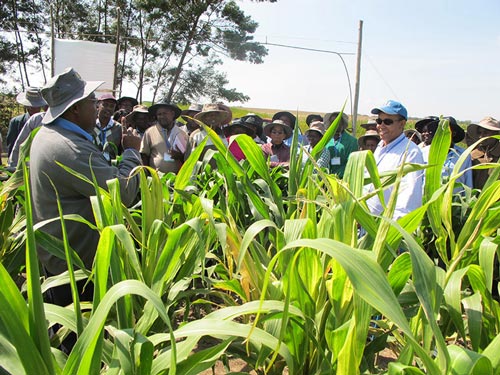 During his opening speech, Joseph Ng’etich, deputy director of Crop Protection, Ministry of Agriculture, noted that about 26,000 hectares of maize in Kenya were affected in 2012, resulting in an estimated loss of 56,730 tons, valued at approximately US$ 23.5 million. Seed producers also lost significant acreages of pre-basic seed in 2012: Agriseed lost 10 acres in Narok; Kenya Seed lost 75; and Monsanto 20 at Migtyo farm in Baringo, according to Dickson Ligeyo, KARI senior research officer and head of Maize Working Group in Kenya.
During his opening speech, Joseph Ng’etich, deputy director of Crop Protection, Ministry of Agriculture, noted that about 26,000 hectares of maize in Kenya were affected in 2012, resulting in an estimated loss of 56,730 tons, valued at approximately US$ 23.5 million. Seed producers also lost significant acreages of pre-basic seed in 2012: Agriseed lost 10 acres in Narok; Kenya Seed lost 75; and Monsanto 20 at Migtyo farm in Baringo, according to Dickson Ligeyo, KARI senior research officer and head of Maize Working Group in Kenya.
While this loss represents only 1.7%, Ligeyo assured everyone that Kenya is not taking any chances and has come up with a raft of measures and recommendations: farmers in areas where rainfall is all year round or maize is produced under irrigation are advised to plant maize only once a year; local quarantine has been enforced and farmers are to remove all infected materials from the fields and stop all movement of green maize from affected to non-affected areas; seed companies must ensure that seeds are treated with appropriate seed dressers at recommended rates, they must also promote good agricultural practices, crop diversification, and rotation with non-cereal crops.
Throughout the workshop, participants learned about theoretical aspects of MLN, such as the disease dynamics, management of MLN trials and nurseries, and identification of germplasm for resistance to MLN. They also participated in practical sessions on artificial inoculation, and identification and scoring. Several CIMMYT scientists played an active role in organizing the workshop, including breeders Stephen Mugo, Biswanath Das, Yoseph Beyene, and Lewis Machida; entomologist Tadele Tefera; and seed systems specialist Mosisa Regasa. They were accompanied by KARI scientist Bramwel Wanjala, KEPHIS regulatory officer Florence Munguti, and NARS maize research leaders Claver Ngaboyisonga (Rwanda), Dickson Ligeyo (Kenya), Julius Serumaga (Uganda), and Kheri Kitenge (Tanzania). During his closing remarks, KARI Food Crops program officer Raphael Ngigi, on behalf of KARI director, urged participants to rigorously implement what they had learnt during the workshop in their respective countries or Kenya regions to help combat MLN at both research farms and farmers’ fields.
Commenting on the usefulness of the workshop, technical officer at KARI-Embu Fred Manyara stated: “I will no longer say I do not know or I am not sure, when confronted by a farmer’s question on MLN.”
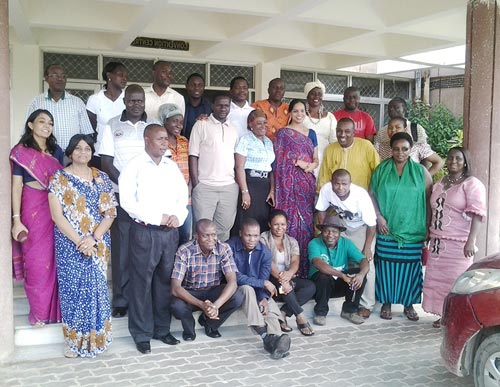
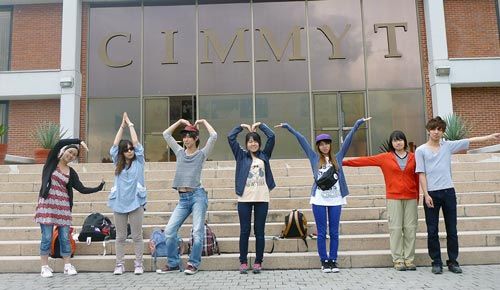
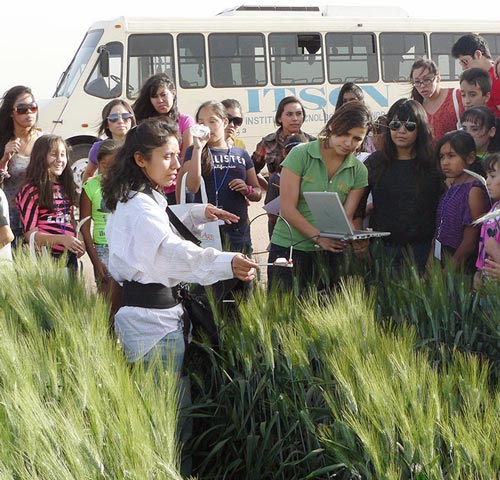
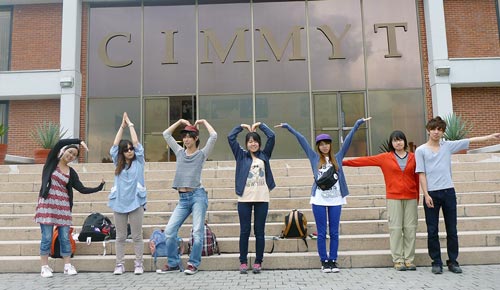
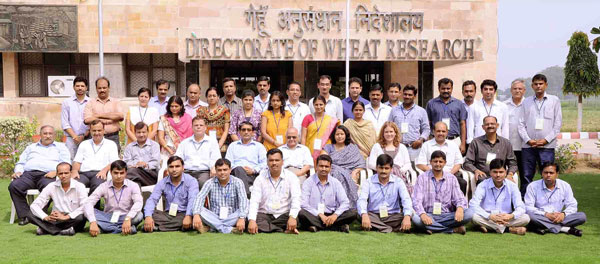 The training was for young scientists from different wheat research stations of India involved in a BMZ-funded project to increase the productivity of wheat under rising temperatures and water scarcity in South Asia. The training program attendees’ enhanced understanding of existing molecular tools for wheat breeding as well as emerging tools such as genomic selection. “Molecular tools will play an increasing role in wheat breeding to meet challenges in coming decades,” said Indu Sharma, director of DWR in Karnal. The program covered both theory and practice on the use of molecular makers in wheat breeding, especially those related to vernalization, photoperiodism and earliness per se, which could be used to enhance early heat tolerance. Practical sessions in the molecular laboratory of DWR focused on extraction of DNA, quantification and quality control of DNA, polymerase chain reaction polymerase chain reaction amplification and electrophoresis.
The training was for young scientists from different wheat research stations of India involved in a BMZ-funded project to increase the productivity of wheat under rising temperatures and water scarcity in South Asia. The training program attendees’ enhanced understanding of existing molecular tools for wheat breeding as well as emerging tools such as genomic selection. “Molecular tools will play an increasing role in wheat breeding to meet challenges in coming decades,” said Indu Sharma, director of DWR in Karnal. The program covered both theory and practice on the use of molecular makers in wheat breeding, especially those related to vernalization, photoperiodism and earliness per se, which could be used to enhance early heat tolerance. Practical sessions in the molecular laboratory of DWR focused on extraction of DNA, quantification and quality control of DNA, polymerase chain reaction polymerase chain reaction amplification and electrophoresis.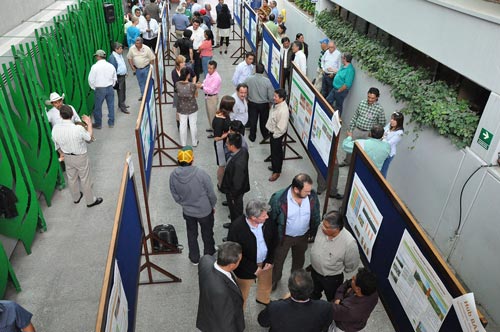 Husband-and-wife duo Oscar Hernández Mendoza and Rosa Elena Montiel Díaz said their work with MasAgro helps them improve the lives of farmers in their town. The two made a presentation about their efforts in Úrsulo Galván, Veracruz, on 29 August during CIMMYT’s first symposium for MasAgro experimental platforms. MasAgro, or the Sustainable Modernization of Traditional Agriculture, is a CIMMYT program coordinated with Mexico’s Ministry of Agriculture, Livestock, Rural Development, Fisheries, and Food (SAGARPA).
Husband-and-wife duo Oscar Hernández Mendoza and Rosa Elena Montiel Díaz said their work with MasAgro helps them improve the lives of farmers in their town. The two made a presentation about their efforts in Úrsulo Galván, Veracruz, on 29 August during CIMMYT’s first symposium for MasAgro experimental platforms. MasAgro, or the Sustainable Modernization of Traditional Agriculture, is a CIMMYT program coordinated with Mexico’s Ministry of Agriculture, Livestock, Rural Development, Fisheries, and Food (SAGARPA).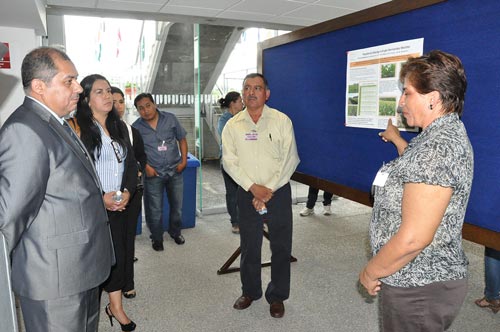 Jesús Rafael Valenzuela Borbón came to the symposium from Navojoa, in southern Sonora. He is trying to bring conservation agriculture practices to farmers in an area where the main problem is a lack of water. Valenzuela is in charge of an experimental site where he is growing maize and wheat using crop rotation. Use of such practices in the area is minimal, though Valenzuela is looking for support to implement them more widely, he explained. “All of the results are very favorable,” he said.
Jesús Rafael Valenzuela Borbón came to the symposium from Navojoa, in southern Sonora. He is trying to bring conservation agriculture practices to farmers in an area where the main problem is a lack of water. Valenzuela is in charge of an experimental site where he is growing maize and wheat using crop rotation. Use of such practices in the area is minimal, though Valenzuela is looking for support to implement them more widely, he explained. “All of the results are very favorable,” he said.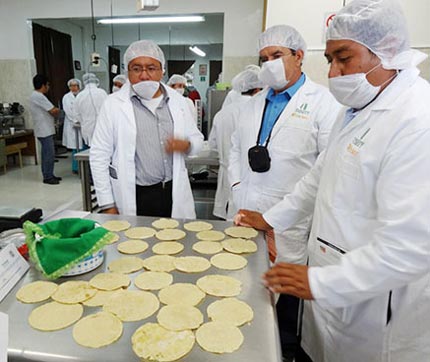 Mexico is the fifth highest maize-consuming country in the world. It is also the number one consumer of maize for food, given that its population eats 70 percent of available maize grain every year. The national food maize groups included in this percentage can be divided into three main types: home consumption, the nixtamalized flour industry and the maize dough and tortilla industry. Businesses in the latter sector must supply maize grain of uniform quality so that maize processing will be more efficient, stable and profitable. With this in mind, 30 Mexican dough and tortilla manufacturers, grain marketers and seed producers attended a practical training course entitled “Maize Grain Quality and Technology” given by researchers from the Sustainable Modernization of Traditional Agriculture (
Mexico is the fifth highest maize-consuming country in the world. It is also the number one consumer of maize for food, given that its population eats 70 percent of available maize grain every year. The national food maize groups included in this percentage can be divided into three main types: home consumption, the nixtamalized flour industry and the maize dough and tortilla industry. Businesses in the latter sector must supply maize grain of uniform quality so that maize processing will be more efficient, stable and profitable. With this in mind, 30 Mexican dough and tortilla manufacturers, grain marketers and seed producers attended a practical training course entitled “Maize Grain Quality and Technology” given by researchers from the Sustainable Modernization of Traditional Agriculture (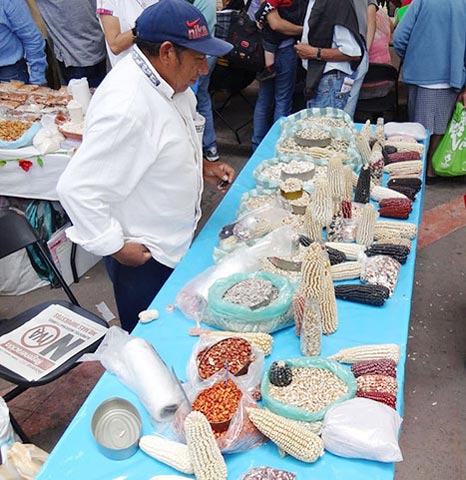 After exchanging their experiences, businessmen, grain merchants and seed producers showed interest in revising Mexican Regulation (Norma Mexicana) 034-1 on grain quality to make the range of values match the current dough- and tortilla-making process. In their opinion, the different links of the maize production chain are increasingly demanding when it comes to the raw materials, processes and products they use. For this reason, Gricelda Vázquez of INIFAP’s Valley of Mexico Experiment Station (CEVAMEX) thinks continued collaboration among research and industrial institutions is needed to ensure that research results extend beyond the production process. As David Tecotl pointed out, “Only by attending these courses at the university do we acquire firsthand knowledge of these important alternatives.” He and his fellow trainees tested the best techniques for mixing nixtamalized flour (of bean, barley, oat, amaranth, and maize) to make more nutritionally rich tortillas, as did the UACh students who are doing their Ph.D. research under the supervision of Ofelia Buendía, one of the course organizers.
After exchanging their experiences, businessmen, grain merchants and seed producers showed interest in revising Mexican Regulation (Norma Mexicana) 034-1 on grain quality to make the range of values match the current dough- and tortilla-making process. In their opinion, the different links of the maize production chain are increasingly demanding when it comes to the raw materials, processes and products they use. For this reason, Gricelda Vázquez of INIFAP’s Valley of Mexico Experiment Station (CEVAMEX) thinks continued collaboration among research and industrial institutions is needed to ensure that research results extend beyond the production process. As David Tecotl pointed out, “Only by attending these courses at the university do we acquire firsthand knowledge of these important alternatives.” He and his fellow trainees tested the best techniques for mixing nixtamalized flour (of bean, barley, oat, amaranth, and maize) to make more nutritionally rich tortillas, as did the UACh students who are doing their Ph.D. research under the supervision of Ofelia Buendía, one of the course organizers.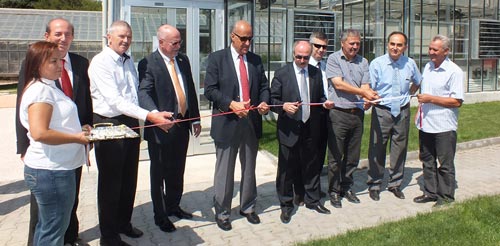
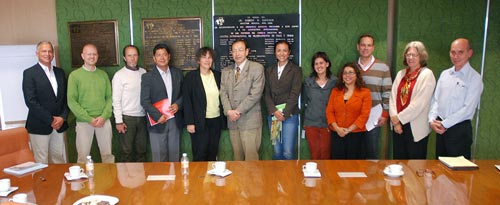
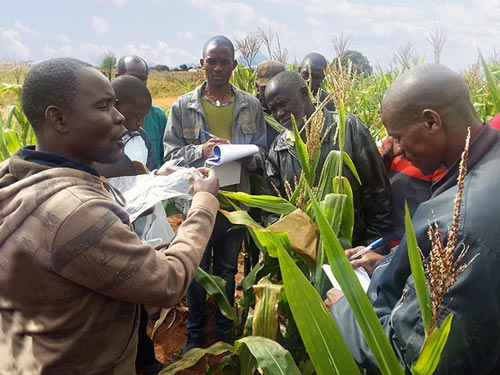
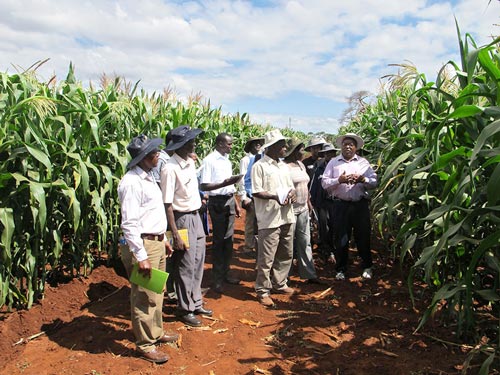 “The trip was an eye opener for me. We have no mass rearing facility in Ethiopia; neither do we practice artificial infestation of stem borers. We only undertake natural infestation for our trials, which does not give uniform infestation, leading us to wrong conclusions,” said Midekssa Ardessa from Bako Agricultural Research Center at the Ethiopian Institute of Agricultural Research (EIAR), who visited CIMMYT-Kenya during 21-27 July 2013 with a team of scientists from Ethiopia, Uganda, Tanzania, and Mozambique, to gain hands-on experience in breeding insect-resistant maize. “We are now very knowledgeable on mass rearing of stem borers and on running an insectary after our visit and practical sessions at the CIMMYT Katumani Insectary,” added Abiy Dibaba from EIAR’s Melkasa Agricultural Research Center. “At the CIMMYT Kiboko Postharvest Lab, we learned a lot about maize weevils and the larger grain borer, and how to screen maize for resistance against these postharvest pests.”
“The trip was an eye opener for me. We have no mass rearing facility in Ethiopia; neither do we practice artificial infestation of stem borers. We only undertake natural infestation for our trials, which does not give uniform infestation, leading us to wrong conclusions,” said Midekssa Ardessa from Bako Agricultural Research Center at the Ethiopian Institute of Agricultural Research (EIAR), who visited CIMMYT-Kenya during 21-27 July 2013 with a team of scientists from Ethiopia, Uganda, Tanzania, and Mozambique, to gain hands-on experience in breeding insect-resistant maize. “We are now very knowledgeable on mass rearing of stem borers and on running an insectary after our visit and practical sessions at the CIMMYT Katumani Insectary,” added Abiy Dibaba from EIAR’s Melkasa Agricultural Research Center. “At the CIMMYT Kiboko Postharvest Lab, we learned a lot about maize weevils and the larger grain borer, and how to screen maize for resistance against these postharvest pests.”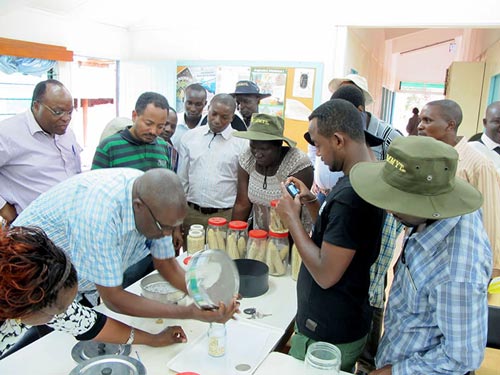 The annual IRMA project’s program has trained more than 50 scientists since its inception in 2009. “Most of us talk very easily and confidently about insect rearing. However, it is quite a challenge when we engage in the practical aspects,” said Tefera. “What we have exposed you to is just a tip of the iceberg in the business of mass rearing of insects. There is still a lot to learn, much of it by yourself as you engage in the practical aspects of it.” The participants appreciated the effort taken by the organizers. One of them, Egas Nhamucho of IIAM, said: “Infestation of maize with stem borers was a real learning point for me, a real delicate task of picking out very tiny 10 insect larvae, ensuring that you do not pierce and kill them with the camel brush, and carefully and strategically placing them on each maize plant. The practical sessions really made me appreciate some of the tasks we have always taken for granted.”
The annual IRMA project’s program has trained more than 50 scientists since its inception in 2009. “Most of us talk very easily and confidently about insect rearing. However, it is quite a challenge when we engage in the practical aspects,” said Tefera. “What we have exposed you to is just a tip of the iceberg in the business of mass rearing of insects. There is still a lot to learn, much of it by yourself as you engage in the practical aspects of it.” The participants appreciated the effort taken by the organizers. One of them, Egas Nhamucho of IIAM, said: “Infestation of maize with stem borers was a real learning point for me, a real delicate task of picking out very tiny 10 insect larvae, ensuring that you do not pierce and kill them with the camel brush, and carefully and strategically placing them on each maize plant. The practical sessions really made me appreciate some of the tasks we have always taken for granted.” “I can now identify with accuracy plants affected with maize lethal necrotic disease,” stated Regina Tende, PhD student attached to CIMMYT, after attending the CIMMYT-Kenya Agricultural Research Institute (
“I can now identify with accuracy plants affected with maize lethal necrotic disease,” stated Regina Tende, PhD student attached to CIMMYT, after attending the CIMMYT-Kenya Agricultural Research Institute ( During his opening speech, Joseph Ng’etich, deputy director of Crop Protection, Ministry of Agriculture, noted that about 26,000 hectares of maize in Kenya were affected in 2012, resulting in an estimated loss of 56,730 tons, valued at approximately US$ 23.5 million. Seed producers also lost significant acreages of pre-basic seed in 2012: Agriseed lost 10 acres in Narok; Kenya Seed lost 75; and Monsanto 20 at Migtyo farm in Baringo, according to Dickson Ligeyo, KARI senior research officer and head of Maize Working Group in Kenya.
During his opening speech, Joseph Ng’etich, deputy director of Crop Protection, Ministry of Agriculture, noted that about 26,000 hectares of maize in Kenya were affected in 2012, resulting in an estimated loss of 56,730 tons, valued at approximately US$ 23.5 million. Seed producers also lost significant acreages of pre-basic seed in 2012: Agriseed lost 10 acres in Narok; Kenya Seed lost 75; and Monsanto 20 at Migtyo farm in Baringo, according to Dickson Ligeyo, KARI senior research officer and head of Maize Working Group in Kenya.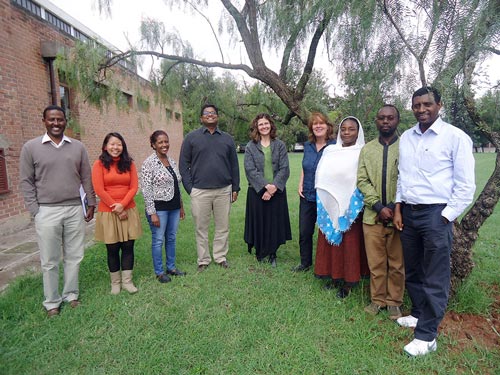 Exploring the potential for integrating gender at a range of scales in the work of the CIMMYT-
Exploring the potential for integrating gender at a range of scales in the work of the CIMMYT- In June 2013, ML Jat (Global Conservation Agriculture Program) and research teams in Bihar and Haryana, India, welcomed CIMMYT gender specialist Tina Beuchelt and gender consultant Cathy Farnworth to discuss integration of gender perspectives into their daily research routine. The visit was triggered by the request from the CRP on Climate Change, Agriculture and Food Security (
In June 2013, ML Jat (Global Conservation Agriculture Program) and research teams in Bihar and Haryana, India, welcomed CIMMYT gender specialist Tina Beuchelt and gender consultant Cathy Farnworth to discuss integration of gender perspectives into their daily research routine. The visit was triggered by the request from the CRP on Climate Change, Agriculture and Food Security (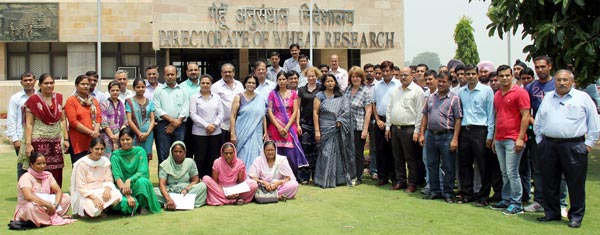 .
.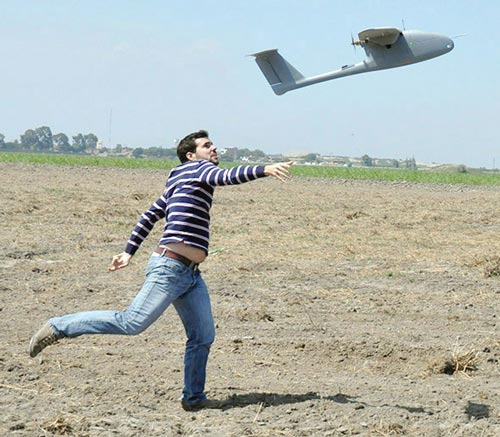 Training on the use of remote sensing from an unmanned aerial vehicle was given at INIAP-Peru’s Vista Florida experiment station on 1-5 June 2013. The course was organized by INIAP, the University of Barcelona, Spain, and CIMMYT’s regional office in Colombia. Remote sensing is used in precision agriculture and for phenotyping crops that are important for the region, such as maize, rice, and sugar cane.
Training on the use of remote sensing from an unmanned aerial vehicle was given at INIAP-Peru’s Vista Florida experiment station on 1-5 June 2013. The course was organized by INIAP, the University of Barcelona, Spain, and CIMMYT’s regional office in Colombia. Remote sensing is used in precision agriculture and for phenotyping crops that are important for the region, such as maize, rice, and sugar cane.